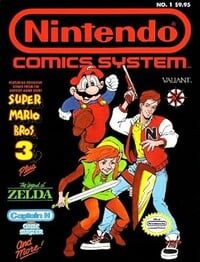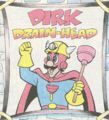Nintendo Comics System
| Nintendo Comics System | |
|---|---|
 The first issue of the Nintendo Comics System | |
| Publisher | Valiant Comics |
- “Comics for Nintendo players!
Now there's an idea! They'd have to be fast-paced. Intelligent. Sophisticated. Literate. Intriguing. Involving. Funny.
Why?
Because Nintendo players are smart, discerning, tasteful people with a sense of humor.
Lots of companies would have loved to have published comics for Nintendo players. But the nice people at Nintendo picked us-VALIANT. They thought we'd do the best job. We will.” - —Introduction to Nintendo Comics System No. 1
The Nintendo Comics System is the umbrella brand for Valiant Comics' line of licensed comics based on Nintendo properties. Running from 1990 to 1991,[1] the comics include stories based on Super Mario, The Legend of Zelda (with some inspirations from the cartoon), Punch-Out!!, Metroid (one story), and Captain N. Issues featured comics based on multiple properties or focused on a single one. Of the properties featured, Super Mario was the most prolific and longest-running.
Publication history[edit]
According to an info page in Nintendo Comics System No. 1, Valiant's deal with Nintendo was announced at a January 1989 conference in New York. Artists drew the story "The Fish That Should've Gotten Away" live for the press, making it the first comic produced under the brand.[2]
In January 1990, an eight-page sneak preview featuring various pages from the upcoming comics and ultimately unused art was published. This was the first comic issue published by Valiant, predating the company's wrestling and self-owned superhero titles.[citation needed]
List of Super Mario media[edit]
- Super Mario Bros. (1990–1991)
- Game Boy (1990)
Non–Super Mario comics with cameos[edit]
- Punch-Out!!
- "Outsiders" (Mario cameo)
- Captain N: The Game Master
- "Welcome to Videoland" (Super Mario Bros. and Donkey Kong cameo)
- "All's Well That Ends Swell" (Donkey Kong cameo)
- "Video-Town" (Donkey Kong cameo)
- "Secrets of the Warp Zones" (Donkey Kong appearance)
Gallery[edit]
- For this subject's image gallery, see Gallery:Super Mario Bros. (Valiant Comics).
"Dear Princess Toadstool," first issue
Naming[edit]
The Nintendo Comics System's title follows the naming scheme of the Nintendo Entertainment System video game console.



